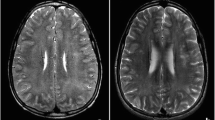Abstract
In a patient with methylmalonic acidaemia (MMAA), persistent neurological symptoms were observed in addition to the acute episodes of metabolic dysequilibrium. CT scan and magnetic resonance imaging revealed bilateral symmetrical necrosis of the globus pallidus. Different episodes of metabolic decompensation, one with severe acidosis, had occurred. Persistent neurological symptoms in patients with MMAA who are appropriately treated suggest irreversible brain damage which appears to occur preferentially at the level of the basal ganglia.
Similar content being viewed by others
Abbreviations
- AdoCbl:
-
adenosyn cobalamin
- CT:
-
computed tomography
- MMA:
-
methylmalonic acid
- MMAA:
-
methylmalonic acidaemia
- MRI:
-
magnetic resonance imaging
References
Adams RD, Lyon G (1982) Neurology of hereditary metabolic disease of children. McGraw-Hill, New York
Baumgartner ER (1983) Activity of the Cobalamin-dependent MMA-CoA mutase. In: Hall CA (ed) The Cobalamins: methods in hematology, vol 10. Churchill Livingstone, Edinburgh, pp 181–195
Chi JG, Yoo HW, Chang KH (1981) Leigh's subacute necrotizing encephalomyelopathy: possible diagnosis by CT scan. Neuroradiology 22:141–144
Heidenreich R, Natowicz M, Hainline BE, Berman P, Kelley RI, Hillman RE, Berry GT (1988) Acute extrapyramidal syndrome in methylmalonic acidemia: “metabolic stroke” involving the globus pallidus. J Pediatr 113:1022–1027
Korf B, Wallman JK, Levy HL (1986) Bilateral lucency of the globus pallidus complicating methylmalonic acidemia. Ann Neurol 20:364–366
Lipkin PH, Roe CR, Goodman SI, Batshaw ML (1988) A case of glutaric acidemia type I: effect of riboflavin and carnitine. J Pediatr 112:62–65
Martin JJ, Van de Vyver FL, Scholte HR, Roodhooft AM, Ceuterick C, Martin L, Luyt-Houwen IEM (1988) Defect in succinate oxidation by isolated muscle mitochondria in a patient with symmetrical lesions in the basal ganglia. J Neurol Sci 84:189–200
Matsui SM, Mahoney MJ, Rosenberg LE (1983) The natural history of the inherited methylmalonic acidemias. N Engl J Med 308:857–861
Peiffer J, Bierich J, Bremer HJ (1974) Methylmalonazidurie, eine therapierbare Ursache spongiöser Hirndystrophie. Zentralbl Allg Pathol 118:541
Rosenberg LE, Fenton WA (1989) Disorders of propionate and methylmalonate metabolism. In: Scriver CR, Baudet AL, Sly WS, Valle D (eds) The metabolic basis of inherited disease, 6th edn. McGraw-Hill, New York, pp 2065–2082
Rosenberg N (1987) Methylmalonic acid, methanol, metabolic acidosis and lesions of the basal ganglia. Ann Neurol 22:96–97
Willard HF, Ambani LM, Hart AC, Mahoney MJ, Rosenberg LE (1976) Rapid prenatal and postnatal detection of inborn errors of propionate, methylmalonate and cobalamin metabolism: a sensitive assay using cultured cells. Hum Genet 34:277–283
Author information
Authors and Affiliations
Rights and permissions
About this article
Cite this article
Roodhooft, A.M., Baumgartner, E.R., Martin, J.J. et al. Symmetrical necrosis of the basal ganglia in methylmalonic acidaemia. Eur J Pediatr 149, 582–584 (1990). https://doi.org/10.1007/BF01957698
Received:
Accepted:
Issue Date:
DOI: https://doi.org/10.1007/BF01957698




